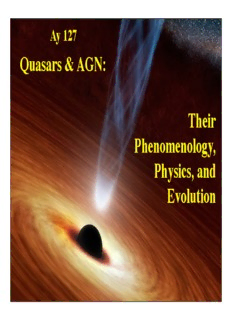
Quasars & AGN: Their Phenomenology, Physics, and Evolution PDF
Preview Quasars & AGN: Their Phenomenology, Physics, and Evolution
Ay 127 Quasars & AGN: Their Phenomenology, Physics, and Evolution Quasars and AGN • They are highly energetic manifestations in the nuclei of galaxies, believed to be powered by accretion onto massive black holes • Empirical classification schemes and various types have been developed, on the basis of the spectra; but recently, various unification schemes have been developed to explain AGN as different appearances of the same underlying phenomenon • Quasars/AGN are observed to evolve strongly in time, with the comoving densities of luminous ones increasing by ~ 103 from z ~ 0 to z ~ 2 • At z ~ 0, at least 30% of all galaxies show some sign of a nuclear activity (mostly low level); ~ 1% can be classified as Seyferts (moderately luminous), and ~ 10-6 contain luminous quasars • However, we think that most or all non-dwarf galaxies contain SMBHs, and thus probably underwent at least one AGN phase AGN, Relativistic jet ’ an artist s view Illumination cone Central black hole Narrow line region Accretion disk Broad line region Black hole: R ~ 10-6 - 10-5 pc Accretion disk: R ~ 10-3 - 10-2 pc Broad line region: R ~ 0.1 - 1 pc Obscuring dusty torus Narrow line region: R ~ 10 - 102 pc Obscuring torus or disk: R ~ 102 - 103 pc Observable Properties of AGN • Energy emission over a broad range of frequencies, from radio to gamma rays – Nonthermal radio or X-ray emission is a good way to find AGN – Generally bluer spectra than stars: “UV excess” – Colors unlike those of stars, especially when modified by the intergalactic absorption • Presence of strong, usually broad emission lines in their spectra • Can reach large luminosities, up to ~ 1015 L • Strong variability at all time scales – Implies small physical size of the emission region • Central engines unresolved • Zero proper motions due to a large distances All of these have been used to devise methods to discover AGN, and each method has its own limitations and selection effects UV-Optical Spectra of Quasars Strong, broad emission lines: Balmer lines of hydrogen Prominent lines of abundant ions Explaining the Broad-Band Spectral Energy Distribution in AGN Thermal emission from dusty Torus (FIR) Thermal emission from accretion Synchrotron Disk (UV) jet (X-ray) Synchrotron jet (radio) AGN Classification • According to radio emission: – Radio loud: radio galaxies (RGs) and quasars; F-R types I and II – Radio quiet (but perhaps not entirely radio silent) • According to optical spectrum: – Narrow-line RGs, Seyfert 2’s; Liners – Broad line RGs, Seyfert 1’s, quasars • According to optical luminosity: – Seyfert to quasar sequence, range of radio powers, etc. • Special types: – Blazars (aka BL Lac’s) and optically violently variable (OVV) objects • These classifications are largely parallel • Some distinction may reflect real, internal physical differences, and some may be simply orientation effects – This is the central thesis of the AGN unification models Types of Seyfert Galaxies Type 1 Seyfert galaxies have in their spectra: • Narrow emission lines, with a width of several hundred km/s • Broad emission lines, with widths up to 104 km/s They also have brighter and bluer nuclei Types of Seyfert Galaxies Type 2 Seyfert galaxies have only the narrow line component: λ (Å) 4000 5000 6000 Both types have high ionization, forbidden lines (= transitions not easily observed in the lab) Spectroscopic Diagnostics Intensity ratios of various emission lines depend on the spectrum of the ionizing continuum radiation: to get lines from high energy levels (e.g., ionizing potentials of tens of eV), one needs “hard” spectra with lots of high energy (UV / soft X-ray) photons. Accretion disks can provide those in AGN, while objects powered by star formation have much “softer” spectra
Description: